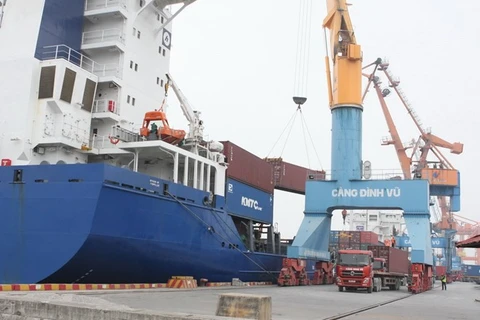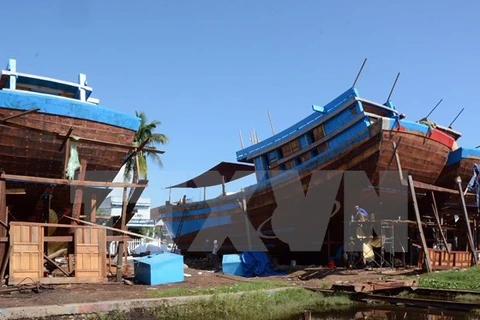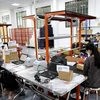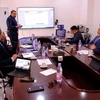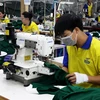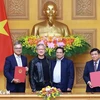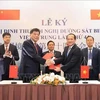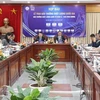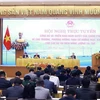Hanoi (VNA) - Vietnam’s maritime and inland waterway transport continue to suffer from the lack of sustainable inland ports and planning for container depots.
They’re also plagued by limited connecting modes of transport and high logistics costs that reduce their potential for market expansion and customer access.
Most recently, Deputy Minister of Transport Nguyen Nhat admitted that the country’s inland waterway transport system still relies heavily on naturally occurring navigable bodies of water, seeing how the State budget is not sufficient to dredge the necessary canals and channels to accommodate heavier shipping watercrafts.
Speaking at a national logistics conference last week, Nhat said that the domestic maritime industry already spends millions of dollars each year on dredging at rivers and estuaries, so they’re left without the capital needed to explore newer options.
He acknowledged that Vietnam’s inland waterway infrastructure in all 63 provinces and cities is still undeveloped, with only 15 planned provincial inland waterway systems.
This means the rest of the country’s extensive river and coastal traffic routes are still a mess, marred by spontaneous or unauthorised ports.
Another major shortcoming experienced by multiple shipping companies is that the domestic waterway port and wharf network is managed simultaneously by central and local authorities, creating redundancies and regulatory confusing and costing firms both time and money.
Mai Le Loi, Vinalines Logistics Vietnam JSC’s General Director, mentioned inefficient, deteriorating and non-uniform seaports systems and equipment as chief concerns for the national logistics industry.
Loi stressed the waterway shipping sector’s inability to connect with land routes as another major weakness. In addition to restricted man-made canals, many other waterways are limited by the bridge height clearance, especially for large transporting barges, such as Duong Bridge or Binh Loi Bridge.
According to Ministry of Transport’s (MoT) statistics, Vietnam has on average one wharf every 350 metres, especially in the Mekong Delta, over a total inland waterway length of about 17,232 kilometres.
This means that canals and rivers are mainly exploited in their natural conditions, lacking connection with other modes of transport, Loi added.
With so many river wharfs in operation, loading and unloading rates are relatively cheap compared to other countries in the region, but since all ports are small-scale, the benefits are limited.
Loi proposed that in order to develop efficient maritime logistics, it is necessary to combine different transport modes and prioritise the development of deep-water ports of sufficient size in the Mekong Delta’s key economic areas, such as Lach Huyen, Da Nang, Cai Mep or Hiep Phuoc Port, to name a few, as focal points connecting international maritime routes.
Hoang Hong Giang, Director of the MoT Inland Waterway Department, noted there are many bottlenecks in both the national maritime transport system and its interconnecting land routes, not to mention the lack of loading equipment and frequent routes changes caused by floods.
Without proper investment in these features, as well as warehouses and shipyards, the state of the national inland waterways and railways systems will continue to go downhill. Additionally, the inadequate signal lights system also poses threats to ships navigating at night, thus reducing the transport capacity of these vehicles, added Giang.
Phung Ngoc Minh, Deputy General Director of Sai Gon New Port Corporation, said that some inland waterway wharfs in HCM City, such as Transimex, Tanamexco, Sotran and Ha Tien Cement, are under the management of both the State and the city, forcing barges to pay double the assigned freight charges.
Quan Dinh Gang, Director of Vinacam Transport JSC, said that overlapping waterway management authority has also undermined foreign investment in waterway infrastructure.
Tran Do Liem, Chairman of the Vietnam Shipping Association, said that across the southern region’s main waterways, there is on average a traffic control station every 15 kilometres, with a lot of unnecessary, expensive and time-consuming inspections for cargo carriers upon entering or leaving the wharfs.
He suggested waterway inspection stations be reduced to only one or two checkpoints per province, with a minimum distance of 50 kilometres between them.-VNA
They’re also plagued by limited connecting modes of transport and high logistics costs that reduce their potential for market expansion and customer access.
Most recently, Deputy Minister of Transport Nguyen Nhat admitted that the country’s inland waterway transport system still relies heavily on naturally occurring navigable bodies of water, seeing how the State budget is not sufficient to dredge the necessary canals and channels to accommodate heavier shipping watercrafts.
Speaking at a national logistics conference last week, Nhat said that the domestic maritime industry already spends millions of dollars each year on dredging at rivers and estuaries, so they’re left without the capital needed to explore newer options.
He acknowledged that Vietnam’s inland waterway infrastructure in all 63 provinces and cities is still undeveloped, with only 15 planned provincial inland waterway systems.
This means the rest of the country’s extensive river and coastal traffic routes are still a mess, marred by spontaneous or unauthorised ports.
Another major shortcoming experienced by multiple shipping companies is that the domestic waterway port and wharf network is managed simultaneously by central and local authorities, creating redundancies and regulatory confusing and costing firms both time and money.
Mai Le Loi, Vinalines Logistics Vietnam JSC’s General Director, mentioned inefficient, deteriorating and non-uniform seaports systems and equipment as chief concerns for the national logistics industry.
Loi stressed the waterway shipping sector’s inability to connect with land routes as another major weakness. In addition to restricted man-made canals, many other waterways are limited by the bridge height clearance, especially for large transporting barges, such as Duong Bridge or Binh Loi Bridge.
According to Ministry of Transport’s (MoT) statistics, Vietnam has on average one wharf every 350 metres, especially in the Mekong Delta, over a total inland waterway length of about 17,232 kilometres.
This means that canals and rivers are mainly exploited in their natural conditions, lacking connection with other modes of transport, Loi added.
With so many river wharfs in operation, loading and unloading rates are relatively cheap compared to other countries in the region, but since all ports are small-scale, the benefits are limited.
Loi proposed that in order to develop efficient maritime logistics, it is necessary to combine different transport modes and prioritise the development of deep-water ports of sufficient size in the Mekong Delta’s key economic areas, such as Lach Huyen, Da Nang, Cai Mep or Hiep Phuoc Port, to name a few, as focal points connecting international maritime routes.
Hoang Hong Giang, Director of the MoT Inland Waterway Department, noted there are many bottlenecks in both the national maritime transport system and its interconnecting land routes, not to mention the lack of loading equipment and frequent routes changes caused by floods.
Without proper investment in these features, as well as warehouses and shipyards, the state of the national inland waterways and railways systems will continue to go downhill. Additionally, the inadequate signal lights system also poses threats to ships navigating at night, thus reducing the transport capacity of these vehicles, added Giang.
Phung Ngoc Minh, Deputy General Director of Sai Gon New Port Corporation, said that some inland waterway wharfs in HCM City, such as Transimex, Tanamexco, Sotran and Ha Tien Cement, are under the management of both the State and the city, forcing barges to pay double the assigned freight charges.
Quan Dinh Gang, Director of Vinacam Transport JSC, said that overlapping waterway management authority has also undermined foreign investment in waterway infrastructure.
Tran Do Liem, Chairman of the Vietnam Shipping Association, said that across the southern region’s main waterways, there is on average a traffic control station every 15 kilometres, with a lot of unnecessary, expensive and time-consuming inspections for cargo carriers upon entering or leaving the wharfs.
He suggested waterway inspection stations be reduced to only one or two checkpoints per province, with a minimum distance of 50 kilometres between them.-VNA
VNA

